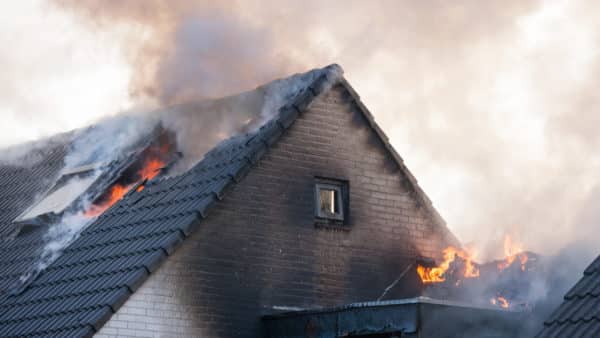Guide to Extinguishing an Electrical Fire

There are few things that can cause as much destruction to a home as an electrical fire. Since many electrical fires start inside walls, an electrical fire can get out of control before you realize there’s a fire at all. Fortunately, if an electrical fire happens, you’re not powerless. Other than calling 9-1-1, there are a few things you can do to help stop small electrical fires in their tracks. Here are a few tips that the pros at Brennan Electric want you to have to be sure you’re prepared if an electrical fire happens in your home.
Don’t Use Water
When there’s a fire, your natural instinct may be to pour water on it to put it out. Unfortunately, if you do that with an electrical fire, it will only make the situation worse. For starters, there’s a good chance that you’ll be electrocuted because water conducts electricity. With you standing in a pool of water and a live electrical circuit nearby, the results aren’t likely to be good. Additionally, an electrical fire’s primary fuel source isn’t the items that the fire is consuming. Instead, the fire’s main source of energy is the electricity that is creating heat, and that won’t go away until you interrupt the electrical circuit.
Stop the Source of Electricity
To quickly extinguish an electrical fire, the first thing that Brennan Electric recommends is to stop the flow of electricity to the fire’s location. In some cases, this may be as simple as unplugging the affected appliance or power strip from the wall. In other cases, you may need to quickly find the circuit breaker panel and turn off the affected breaker. If you don’t know which breaker you’re looking for, just turn them all off and figure it out later. Stopping the flow of electricity will reduce the amount of heat that’s available at the site of the fire. Since fire needs heat to burn, you will likely be able to get the fire under control after completing this step. Plus, with the electricity turned off, you can more safely manage the fire using other methods.
Use the Correct Fire Extinguisher
Once you stop the flow of electricity to the site of the fire, you’ll want to use a fire extinguisher to put out the flames. Even with no electricity flowing, though, you need to be careful about the type of fire extinguisher that you use. A fire extinguisher that’s rated for Type C fires is safe to use with an electrical fire. Some types of extinguishers are only rated for Type C fires, while other extinguishers are rated for multiple types of fires, including Type C fires. When using a fire extinguisher, make sure that you aim at the base of the fire and use back-and-forth sweeping motions to completely extinguish the flames. Furthermore, make sure that your extinguisher is properly charged and up-to-date so that you can be sure it will work when you need it.
Use Baking Soda
If you find yourself facing an electrical fire and you don’t have a fire extinguisher on hand, you can also use baking soda to put out the flames. In fact, baking soda, also known as sodium bicarbonate, is essentially exactly what’s in a Type C fire extinguisher. When exposed to heat, sodium bicarbonate releases carbon dioxide. This quick release of carbon dioxide starves the fire of the oxygen it needs to continue burning, thereby putting it out. Additionally, the baking soda forms a barrier over the combustible materials so that oxygen can’t reach the base of the flames.
Use a Heavy Blanket
Sometimes, there’s no time to find a fire extinguisher or baking soda. If you find yourself in that situation, try reaching for a heavy blanket as a last resort. Brennan Electric specifically recommends using a fire blanket for this task since it’s made from flame-resistant material. However, any heavy blanket can work in a pinch. In order for a regular blanket to work, the fire must be fairly small. Otherwise, there will likely be enough heat for the fire to ignite the blanket. For small fires, a heavy blanket helps to starve the fire of oxygen, quickly extinguishing it. When using a blanket, make sure to let the blanket do the work. Do not hold or lay on the blanket to provide extra pressure because the blanket could catch on fire and burn you.
Don’t Be a Hero
While small electrical fires that happen outside of wall cavities can be frightening, they are generally fairly easy to extinguish. However, in-wall fires can smolder and re-ignite even if you’re able to extinguish the main fire. If one of these fires catches you off-guard, Brennan Electric wants to remind you that you don’t have to be a hero. While it’s great to try and prevent fire damage in your home if you can, a fire can quickly overwhelm you to the point that you can’t escape your home. Put forth your best effort, but know that you may still need to call the fire department to help put the fire out for good. Even if you think you’ve extinguished an electrical fire, it may still be good to have the fire department come to make sure there are no unseen hotspots.
Signs of an Electrical Problem
In most cases, an electrical fire happens after many other warning signs occur. If you can recognize these warning signs, you’ll be better equipped to stop a fire before it starts. One sure sign that a fire is imminent is if you notice that an outlet or electrical cord is exceptionally hot. Most electrical devices produce some heat when they’re working. However, if you touch an outlet, cord, or electrical device and you have to pull your hand away because it’s so hot, there’s likely a problem with something in the electrical chain. If you hear popping noises coming from an outlet or power strip, that’s another tell-tale sign that something’s amiss. Finally, if you smell burning plastic, this means there’s enough heat to create a fire, and you need to act immediately before disaster strikes.
Avoiding an Electrical Fire
Ideally, you’ll never get to the point where you have to recognize the signs of an imminent electrical fire. Here are a few tips from Brennan Electric to help you stay safe while using electricity. First and foremost, don’t try to overload electrical outlets or circuits. Most circuits are rated for 15 or 20 amps. Don’t use more power than that on a single circuit, or the electrical wires and outlets will overheat. Additionally, make sure to unplug any non-essential electrical devices when they’re not in use. Entirely removing a device from its source of electricity will guarantee that that device can’t catch on fire when you’re not around.
Your Electrical Safety Specialists
Safety is our most important concern at Brennan Electric. That’s why we take every possible precaution when performing electrical repairs, installing electrical panels, installing new lights, wiring hot tubs, and performing our other available services. For over 35 years, this commitment to excellence has helped us gain a reputation for quality service and outstanding results. That’s why we were able to earn an Angie’s List Super Service Award and continually receive five-star customer reviews. To learn more about electrical safety in Seattle, contact us at Brennan Electric today.

